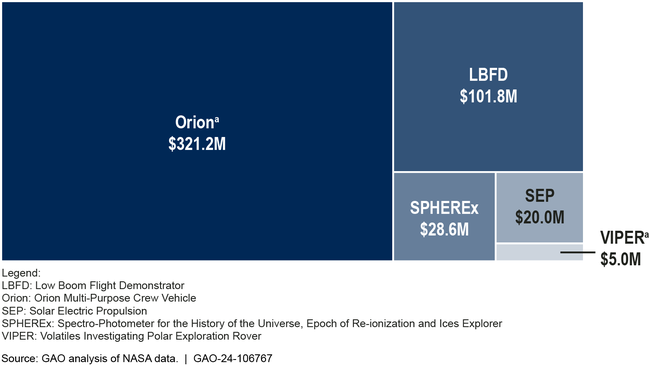NASA: Assessments of Major Projects
Fast Facts
NASA plans to invest more than $82 billion in its major projects to continue exploring Earth, the moon, and the solar system. This is our 16th annual assessment of these projects.
The projects' total overruns—when costs incurred are more than NASA planned for—decreased by over $3 billion in the last year. NASA's largest projects continue to have the biggest impact on these overruns. For example, a key factor in the decrease was that two large projects completed development and no longer count toward the overruns.
NASA is taking steps to better manage its major projects, but its acquisition management remains on our High Risk List.
NASA’s Largest Projects, Like Orion, Increase Cost Overruns the Most

Highlights

What GAO Found
Since 2023, NASA's cumulative cost and schedule performance has improved. Cost overruns decreased from $7.6 billion in 2023 to $4.4 billion in 2024. Schedule overruns decreased from a total of 20.9 years in 2023 to 14.5 years in 2024. These decreases are primarily because two projects, the Space Launch System and Exploration Ground Systems, demonstrated their initial capability and left the portfolio. Previously, these projects accounted for $3.6 billion in cost overruns and each experienced delays of 4 years.
NASA's Cumulative Development Cost Overruns by Project, 2023-2024

Note: Due to rounding, the numbers in the figure do not sum to the total cumulative cost overruns of $4.4 billion for 2024.
Category 1 projects—NASA's highest priority and most costly—continue to drive NASA's cumulative cost performance. While the departure of the Space Launch System and Exploration Ground Systems from the portfolio improved cumulative performance, the remaining category 1 projects accounted for 81 percent of the portfolio's total cumulative baseline overrun in 2024. One of these category 1 projects, the Orion Multi-Purpose Crew Vehicle (Orion), accounted for 65 percent ($2.9 billion) of the portfolio's total cumulative baseline cost overrun.
NASA's Artemis-related category 1 projects are positioned to shape the agency's cumulative cost performance in the coming years. The Artemis enterprise aims to return U.S. astronauts to the surface of the moon, establish a sustained lunar presence, and ultimately achieve human exploration of Mars. Currently, eight of the 14 category 1 major projects are Artemis-related. In December 2023, NASA set development cost baselines—estimates against which performance on a project is measured—totaling $9.6 billion for three Artemis projects: the Space Launch System Block 1B, Gateway Initial Capability, and Human Landing System Initial Capability. These three projects and Orion, which also supports the Artemis missions, now account for nearly 60 percent, or $19.2 billion, of the portfolio's $32.1 billion development costs. Because these projects' development cost baselines are so large, any overruns could have cascading effects on NASA's broader portfolio of major projects.
Regardless of their category, most of the projects in development did not experience annual cost growth or schedule delays since 2023. Specifically, 11 out of the 16 major projects in development did not experience cost growth in 2024, and 13 out of the 16 reported no schedule delays this year. Below are the five projects that experienced cost growth totaling $477 million since 2023.
Annual Development Cost Growth for Major NASA Projects since GAO's 2023 Assessment

Note: Data are as of January 2024. This figure reflects cost increases against what was reported in GAO's May 2023 annual assessment of major projects. This figure does not include projects that reported cost underruns since GAO's last report.
aThe cost estimates for the Orion and VIPER projects are under review.
NASA has taken steps to improve the performance of its major projects, including those supporting the Artemis missions. In 2023, in response to statute, NASA established the Moon to Mars program office to manage the Artemis programs. It also completed several initiatives to strengthen its cost and schedule estimating capacity. NASA officials reported that they have also established a Chief Program Management Officer who works to strengthen NASA's program and project management policies and best practices in support of increasing performance and enabling long-term mission success for NASA.
GAO previously made recommendations to help NASA demonstrate progress in improving portfolio performance, including for those major projects supporting the Artemis missions. GAO will continue to monitor NASA's efforts in this area.
In addition to its efforts to improve portfolio performance, NASA has also taken steps to mature its critical technologies in its major projects. Of the 11 projects that reported critical technologies in 2024, the projects assessed that nine matured their technologies to technology readiness level 6 by their preliminary design review. Achieving this level involves demonstrating a representative prototype of the technology in a relevant environment. GAO's past work shows that maturing technologies prior to product development can help reduce technology-related cost increases and schedule delays.
Why GAO Did This Study
NASA plans to invest more than $81 billion in its portfolio of major projects (i.e., projects over $250 million). A House explanatory statement includes a provision for GAO to prepare status reports on NASA's major projects. This is GAO's 16th annual assessment.
This report describes GAO's assessment of the cost and schedule performance of NASA's major projects, and NASA's assessment of the projects' technology development. GAO also assessed the status of each major project.
GAO collected and analyzed data; reviewed project status reports; and interviewed officials. GAO reviewed projects in the formulation phase (which takes a project through its preliminary design), and those in the development phase (which includes building and launching the system).
Recommendations
In prior work, GAO made multiple recommendations to improve NASA's management of these projects, and NASA has generally agreed with them. As of April 2024, NASA had not yet fully implemented 39 GAO recommendations, including eight that GAO identified as high priority.
